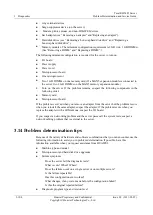
Tecal RH5485 Server
Problem Determination and Service Guide
5 Removing and replacing components
Issue 02 (2011-05-25)
Huawei Proprietary and Confidential
Copyright © Huawei Technologies Co., Ltd.
5-1
5
Removing and replacing components
Replaceable components are of four types:
Consumable part:
Purchase and replacement of consumable parts (components, such as
batteries and printer cartridges, that have depletable life) is your responsibility. If
HUAWEI acquires or installs a consumable part at your request, you will be charged for
the service.
Tier 1 customer replaceable unit (CRU):
Replacement of Tier 1 CRUs is your
responsibility. If HUAWEI installs a Tier 1 CRU at your request, you will be charged
for the installation.
Tier 2 customer replaceable unit:
You may install a Tier 2 CRU yourself or request
HUAWEI to install it, at no additional charge, under the type of warranty service that is
designated for your server.
Field replaceable unit (FRU):
FRUs must be installed only by trained service
technicians.
See Chapter 4, “Parts listing, RH5485,” to determine whether a component is a Tier 1 CRU,
Tier 2 CRU, or FRU.
5.1 Installation guidelines
Before you remove or replace a component, read the following information:
Read the safety information that begins, “Working inside the server with the power on”,
and “Handling static-sensitive devices”. This information will help you work safely.
When you install your new server, take the opportunity to download and apply the most
recent firmware updates. This step will help to ensure that any known issues are
addressed and that your server is ready to function at maximum levels of performance.
To download firmware updates for your server, complete the following steps.
Before you install optional hardware devices, make sure that the server is working
correctly. Start the server, and make sure that the operating system starts, if an operating
system is installed, or that a 19990305 error code is displayed, indicating that an
operating system was not found but the server is otherwise working correctly. If the
server is not working correctly, see Chapter 3, “Diagnostics,” for information about how
to run diagnostics.
















































